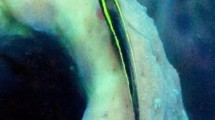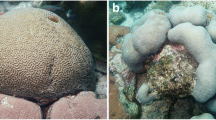Abstract
Six species of common Caribbean Zoanthidea, Parazoanthus swiftii, P. parasiticus, P. catenularis, P. puertoricense, Epizoanthus cutressi, and Epizoanthus sp., are virtually restricted to living on surfaces of reef-dwelling sponges. Quantitative surveys on Barbados reefs indicate that substrate specificity is relatively high among these zoanthids with three restricted to a single primary host sponge species and three restricted to three closely related sponges. One species, P. swiftii, exhibits a broad range of acceptable secondary substrates, due to its unique ability to execute migrational spread in the adult polyp stage. Variations in substrate specificity have been noted between island populations within the extensive Caribbean range and appear to be due to different species compositions of local sponge communities and slight differences in zoanthid larval settling specificities.
Similar content being viewed by others
Literature Cited
Bergquist, P. R.: Sponges, 268 pp. Berkeley-Los Angeles: University of California Press 1978
Connell, J. H.: Effects of competition, predation by Thais lapillus and other factors on natural populations of the barnacle Balanus balanoides. Ecol. Monogr. 31, 61–104 (1961)
Connell, J. H.: Population ecology of reef building corals. In: Biology and geology of coral reefs, Vol. 2, pp. 204–244. Ed. by O. A. Jones and R. Endean. New York: Academic Press 1973
Crisp, D. J.: Dispersal and re-aggregation in sessile marine invertebrates, particularly barnacles. In: Biology and systematics of colonial organisms, pp. 319–327. Ed. by G. Larwood and B. R. Rosen. London: Academic Press 1979
Dayton, P. K.: Competition, disturbance, and community organization: the provision and subsequent utilization of space in a rocky intertidal community. Ecol. Monogr. 41, 351–389 (1971)
Forbes, M. L.: Life cycle of Ostrea permollis and its relationship to the host sponge, Stelletta grubii. Bull. mar. Sci 16, 273–301 (1966)
Frost, T. M.: Investigations of the aufwuchs of freshwater sponges. I. A quantitative comparison between the surfaces of Spongilla lacustris and three aquatic macrophytes. Hydrobiologia 50, 145–149 (1976)
Glynn, P. W.: Aspects of the ecology of coral reefs in the western Atlantic region. In: Biology and geology of coral Reefs, Vol. 2, pp. 271–319. Ed. by O. A. Jones and R. Endean. New York: Academic Press 1973
Humason, G. L.: Animal tissue techniques, 3rd Ed., 641 pp. San Francisco: W. H. Freeman and Sons 1972
Jackson, J. B. C.: Competition on marine hard substrata: the adaptive significance of solitary and colonial strategies. Am. Nat. 111, 743–767 (1977)
Kinzie, R. A.: Experimental infection of aposymbiotic gorgonian polyps with zooxanthellae. J. exp. mar. Biol. Ecol. 15, 335–345 (1974)
Kinzie, R. A. and G. S. Chee: The effect of different zooxanthellae on the growth of experimentally reinfected hosts. Biol. Bull, mar. biol. Lab., Woods Hole 156, 315–327 (1979)
Long, E. R.: The associates of four species of marine sponges of Oregon and Washington. Pac. Sci. 22, 1049–1074 (1968)
Macintyre, I. G.: Submerged coral reefs, west coast of Barbados, West Indies. Can. J. Earth Sci. 4, 471–474 (1967)
Paine, R. T.: Intertidal community structure. Experimental studies on the relationship between a dominant competitor and its principal predator. Oecologia 15, 93–120 (1974)
Pearse, A. S.: Notes on the inhabitants of certain sponges at Bimini. Ecology 31, 149–151 (1949)
Reiswig, H. M.: Population dynamics of three Jamaican Demospongiae. Bull. mar. Sci. 23, 38–50 (1973)
Rutzler, K.: Loxosomella from Tedania ignis, the Caribbean fire sponge. Proc. U. S. Nat. Mus. 124, 1–11 (1968)
Schoenberg, D. A. and R. K. Trench: Specificity of symbiosis between marine cnidarians and zooxanthellae. In: Coelenterate ecology and behavior, pp. 423–432. Ed. by G. O. Mackie. New York-London: Plenum Press 1976
Stanton, G.: Habitat partitioning among associated decapods with Lebrunia danae at Grand Bahama. In: Proc. 3rd int. Symp. coral Reefs, 2 (Biology), pp. 169–175. Ed. by D. L. Taylor. Miami: University of Miami Press 1977
West, D. A.: Symbiotic zoanthids (Anthozoa: Cnidaria) of Puerto Rico. Bull. mar. Sci. 29, 253–271 (1979)
Wilson, D. P.: The influence of the nature of the substrate on the metamorphosis of the larvae of marine animals especially the larvae of Ophelia bicornis Savigny. Ann. Inst. Oceanog. (Paris) N. S. 28, 49–156 (1952)
Author information
Authors and Affiliations
Additional information
Communicated by R. O. Fournier, Halifax
Rights and permissions
About this article
Cite this article
Crocker, L.A., Reiswig, H.M. Host specificity in sponge-encrusting zoanthidea (Anthozoa: Zoantharia) of Barbados, West Indies. Mar. Biol. 65, 231–236 (1981). https://doi.org/10.1007/BF00397116
Accepted:
Issue Date:
DOI: https://doi.org/10.1007/BF00397116




